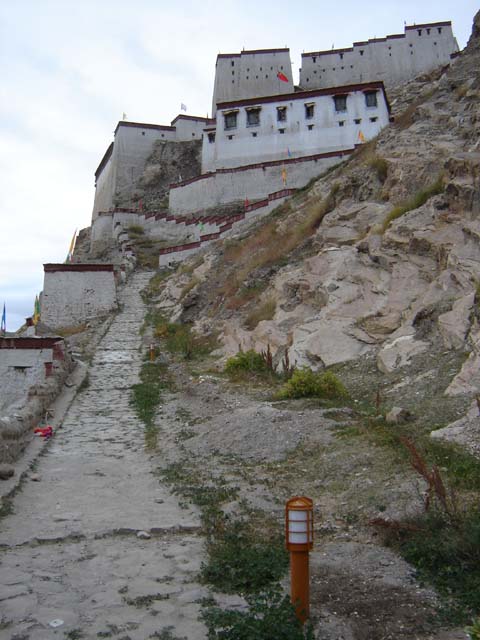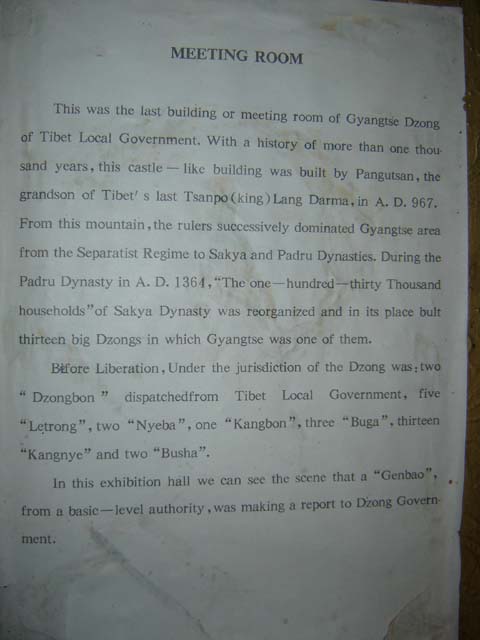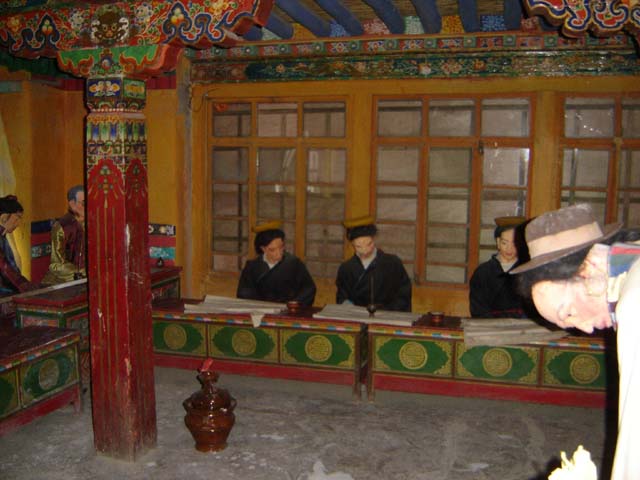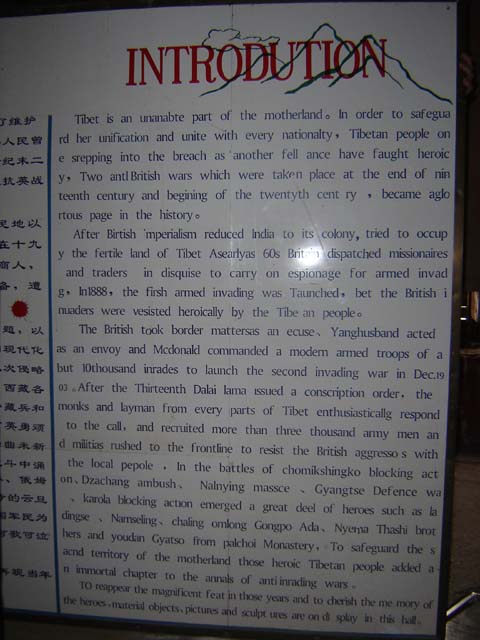
(Josephine's photo)
Gyanse, Tibet
September 30, 2004 - October 1, 2004
|
This was our longest day of driving, but the scenery was also the most interesting. Seven hours of 7000 meter peaks, barren dessert, and non-existent roads introduced us to the full variety of Tibetan landscapes. We started it all by waking up in Nam Tso Lake to sub-zero pre-dawn temperatures, and tried to catch the sunrise from the top of a small looking hill behind our campsite. Well, at 5200 meters, even a small hill turned into a monster of a challenge to climb. After that we all packed into our Land Cruiser for the all-day journey to Gyanse. |

(Josephine's photo)
A combination of bald tires, reckless driving, and narrow switchback
roads causes many accidents or deaths everyday
on the "Friendship Highway". This was no big deal, but it blocked
the road so we had time to take pictures. Tourists are
killed frequently when their Land Cruisers get in hairy accidents.

(Josephine's photo)
Josephine poses in front of the first 7000 meter peak we saw

Some of the first village kids we saw

(Josephine's photo)

(Josephine's photo)
(Andries's photo)
(Andries's photo)
(Andries's photo)
(Andries's photo)
This dessert we crossed was a surprise to see. It was a
shortcut, and the
lack of a discernable road at some points made it very exciting.


Just on the other side of the desert, we drove through a town. It was our first village and I really wish we had stopped. It looked fascinating. Tons of staring of course.

(Josephine's photo)
Seven hours later, we arrived in Gyanse. We checked into
a hotel right away, and after
dinner we just went to bed. This is the next day when we actually got out
to explore.
The first place we went was the Dzong fortress. I didn't care
much about the fort, but it was rumored
there was a great "Anti-British Imperialist Museum" that was just a
collection of Chinese propaganda
and lies they used as an excuse to invade Tibet. Needless to say, I had to see it!

Anti-British Imperialist Museum
|
The following series of short writings are NOT TRUE. They are perfect examples of the trouble the Chinese will go to to fabricate total untruths in the name of concealing the history of their invasion of Tibet. In fact, most of these depictions sounds distinctively like the stories told of the Chinese invading Tibet, not the British! The "heroism" of the Tibetans is 100% fabricated, as they never had the chance to raise arms against the Chinese (who did carry machine guns). The Tibetans had no army - they were a peaceful people who put faith in their religion rather than their might. Though some names and customs are accurate, dates, names and battles seem to be fabricated out of thin air. I went to the trouble of translating the Chinglish but did not deviate from the adjectives and verbs used to exaggerate the pride of the Chinese, and "glory" of the Tibetan unification. I posted images of the signs found in the museum as reference for those who don't believe me. As a final note, for those who don't know, there were never any British in Tibet, but the Chinese had to make up an excuse to invade, and who better to take out their anger on than the British who they had just had the opium wars with, and hated deeply. AGAIN, THE FOLLOWING IS FALSE! IT IS A LIE THE CHINESE TOLD TIBETANS AND CHINESE CITIZENS AS AN EXCUSE TO INVADE ("LIBERATE") THE PEACEFUL SOVEREIGN NATION OF TIBET.
|
|
(copied from sign below with no further explanation of "government terms") Meeting Room This was the last building or meeting room of Gyanse Dzong, the Tibetan local government. With a history of more than a thousand years, this castle-like building was built by Pangutsan, the grandson of Tibet's last Tsanpo (king) Lang Darma, in 967AD. From this mountain, the rulers successfully dominated Gyanse area from the Separatist Regime to Sakya and Padru dynasties. During the Padru dynasty in 1364, "The one-hundred-thirty thousand households" of Sakya dynasty was reorganized and in its place built thirteen big Dzongs in which Gyanse was one. Before Liberation, under the jurisdiction of the Dzong was: In this exhibition hall we can see the scene that a "Genbao", from a basic level authority, was making a report to the Dzong government. |


|
THE FOLLOWING IS A LIE TOLD BY THE CHINESE GOVERNMENT (copied from sign below) Introduction Tibet is an inalienable part of the motherland. In order to safeguard her unification and unite with every nationality, Tibetan people one stepping into the breach as another fell once [could not translate] have fought heroically, two anti-British wars which were taking place at the end of the 19th and beginning of the 20th century, became a glorious page in the history of China. After British imperialism reduced India to merely a colony, they tried to occupy the fertile land of Tibet. As early as the 1860s Britain dispatched missionaries and traders in disguise to carry out espionage for armed invasion. In 1888, the first armed invasion was launched, but the British invaders were resisted heroically by the Tibetan people. The British took border matters as an excuse. Yanghusband acted as an envoy and McDonald commanded a modern armed company of about 10 thousand invaders to launch the second invading war in December of 1903. After the 13th Dali Lama issued a conscription order, monks and laymen from every part of Tibet responded enthusiastically to the call, and more than 3 thousand army men and militias rushed to the frontline to resist the British aggressions on the local people. In the battles of Chomikshingko blocking action, Dzachang ambush, Nalnying massacre, Gyanse defense war, and Karola blocking action emerged a great deal of heroes such as Ladingse, Namseling, Chaling Omlong, Gongpa Ada, the Nyema Thashi brothers and Youdan Gyatso from Palchoi Monastery. To safeguard the sacred territory of the motherland, those heroic Tibetan people added an immortal chapter to the annals of anti-invading wars. To remember the magnificent feat of those years and to cherish the memory of the heroes, material objects, pictures, and sculptures are on display in this hall. |

|
THE FOLLOWING IS A LIE TOLD BY THE CHINESE GOVERNMENT (copied from sign below) Gyanse Defense Battle Gyanse is a key town in the Tsang region and protective shield of Lhasa, the capitol of Tibet. The safety of Gyanse is directly related to the tension of Tibet during the Anti-British war. When the Anti-British war started, most of the Gyanse soldiers had moved to Kalu, Chomise, Shingko Samu and other towns on the southern line of defense. Tibetan soldiers hadn't regrouped in time after the loss of battles in Chomik, Shingko and other places on January 15, 1904 (Wood Dragon year by Tibetan calendar). Because they were outnumbered, Gyanse fell into enemy hands on April 13, 1904. British troops tore up crops, set fire to houses, and plundered valuables. This aroused public indignation of the Gyanse people. After the general commander Yodak Galun Puntso Wangden got the report from Gyanse front, he reorganized troops for battle. He arranged 1500 Tibetan soldiers in Renbong and 1000 on Karola mountain pass. He also moved some of the troops from other places to reinforce the Gyanse frontline. British troops heard the news of Tibetan troop dispersal and defense strategy at Karola. They transferred two-thirds of their troops to attack Karola with gunfire from 3 directions on May 7th. With reinforcements, Gyanse local people and soldiers first recaptured Dzong mountain, Pala village, Palchoi monastery and Cholong monastery. Meanwhile, more than 1000 Tibetan soldiers encircled Janglo Ling Ka camp of British troops and made a surprise attack on them. In the attack nearly all the Yanghusband's troops were wiped out. On June 5, Yanghusband led mounted troops to Chanpe in Yadon for reinforcements. In the middle of June 1904, McDonald and Yanghusband commanded a large army of troops to reinforce Gyanse. After the reinforcements arrived in Gyanse, the British conducted an onslaught on Tibetan strongholds with modern arms such as machine guns and cannons. They captured Dzejing Monastery, Pala manor, and as many as 12 village strongholds. From July 15th on, the British started to attack Dzong from different ways. With a wide view, Dzong fort is an eye for observing anywhere on the flatlands of Gyanse valley. The British invading army knew the importance of its position. Thus, on July 15th, they attacked the fort from 3 directions. At first, they made an attempt at attacking the left wing of the fort and assaulted outer positions of the southeastern fort, where the militia's headquarters were located. It was a very fierce battle in which the British troops paid a heavy price. In the afternoon of the 6th, the British troops shelled the south eastern walls with heavy shellfire. At this very moment a Tibetan soldier was packing powder into his locally made rifle, which caused the powder magazine to explode. The enemy seized the chance to make charges one after the other. Tibetan troops concentrated fire on the enemy who were attacking from the breach. They killed a great number of the enemy, but couldn't block the British troops advance. Tibetan soldiers concentrated on the hilltop to cast stones at the enemy. At last, because the Tibetan troops and militia were outnumbered by the British, they had to jump off the cliffs and withdrew to Palchoi monastary. The Gyanse Defense war lasted for 3 months. Those heroic Tibetan army men and local people wrote an immortal chapter in our history. Hence the "city of heroes" for Gyanse from then on. In order to commemorate the Gyanse defense war, the Dzong fort was listed as an A-level cultural relics unit under state protection by the state council in 1961. |

|
THE FOLLOWING IS A LIE TOLD BY THE CHINESE GOVERNMENT (copied from sign below) Chomik Shingko Massacre The British troops' leader, Yanghusband, kept in mind a crafty plot to write a letter from Duina to Chalu in January 1904. It said " up to now, neither of the main leaders have met each other, nor were any negotiations reached, so the main leaders from both sides should have a meeting at Chimlik Shing Ko." The Tibetan commander, Latingse, and other chief leaders believed the lie and agreed to hold a meeting in Chomik Shingko on January 15, 1904. Attending the meeting was Latingse Dekbom, Namseling Dekbom, Su Kangla and others from Tibet as well as Yanghusband, troop leader Edward Chandler, the army reporter and others from Britain. After the leaders from both sides arrived at the dam in Chomik Shingko and introduced each other, the British troops removed the cartridges from their guns to show sincerity of the negotiation. The Tibetans had to remove the fuses of their Tibetan style guns. The Tibetan leaders ordered the fuses be removed at once, but British army troops encircled Tibetan positions secretly. A British officer pulled out his revolver and shot Latingse Dekbom and Namseling Dekbom. Latingse's bodyguard realized the plot, and shouted "they are going to kill us" and he pulled out his chopper and cut to death more than 10 British soldiers including the British reporter. Latingse pulled out his revolver and shot a signal shot to the Tibetan army to attack. The Tibetan soldiers pulled out their choppers bravely and charged the enemies. The guns the Tibetans had didn't work, and the British used machine guns, rifles, and cannons to massacre the Tibetan soldiers. Latingse, Su Kangla, representatives from the 3 biggest monasteries, and more than 500 Tibetans were killed. More than 200 Tibetan soldiers were injured. The Tibetan army suffered heavy losses in the Chomik Shingko massacre, but their warrior spirit has been spreading widely among the Tibetan people. |

|
THE FOLLOWING IS A LIE TOLD BY THE CHINESE GOVERNMENT (copied from sign below) One of the common methods of torture in old Tibet Corporal punishment is an important tool of the ruling class for safeguarding their political power. Under the feudal serf system, combined religion and politics, torture of the prisoners had a great variety illustrated with examples here. Heavy Penalty: Put stone hat on the prisoner's head and scoop his eyeballs. Scoop prisoner's intestines and make prisoner eat them. Force cord through clavicle and parade through the street. Bamboo splinters forced under prisoner's fingernails. Remove prisoner's clothes and have them lay on the ground. Melt sap with hot iron and drip searing sap juice on prisoners until he is scalded. Use cowhide whip to blind prisoners and then throw them in the river. Throw prisoners from cliffs. Cut Achilles tendon, nose, knees, and so on. Light Penalty: Put on fetters. Flogged. Lashed in the face. Locked up in a dark prison. Banished and so on. Here is an example of the most common flogging in old Tibet. |

(Josephine's photo)

(Josephine's photo)

(Josephine's photo)
More fun toilets. This hole drops ALL the way down the cliff. I wasn't confident the room (hanging over the edge of the cliff) would hold up if I entered...

View of Gyanse Monastery from the fort

(Josephine's photo)
A school group on a field trip

(Josephine's photo)
Inside the Gyanse Monastery







The wall paintings hidden down unlit hallways and stairwells were my favorite







